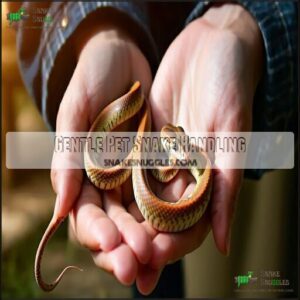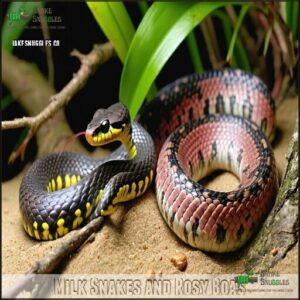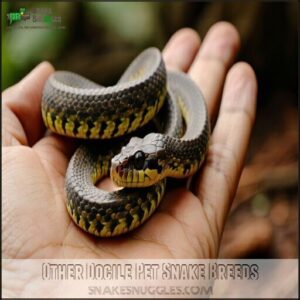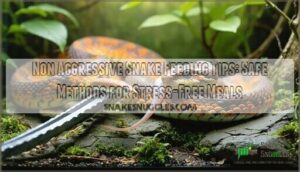This site is supported by our readers. We may earn a commission, at no cost to you, if you purchase through links.
 Looking for friendly pet snake breeds that won’t give you the heebie-jeebies? You’re in luck!
Looking for friendly pet snake breeds that won’t give you the heebie-jeebies? You’re in luck!
Corn snakes, ball pythons, and California kingsnakes are the superstars of the snake world in terms of being beginner-friendly.
These docile reptiles are known for their calm temperament and manageable size. They’ll slither right into your heart with their gentle nature and relatively low-maintenance care.
Whether you’re a first-time snake owner or a reptile enthusiast, these breeds are perfect for handling and bonding. Just remember, every snake has its own personality, so patience and consistent, gentle interaction are key to building a trusting relationship.
Table Of Contents
- Key Takeaways
- Friendly Pet Snake Breeds
- Docile Snake Species
- Pet Snake Care Requirements
- Gentle Pet Snake Handling
- Popular Friendly Pet Snakes
- Frequently Asked Questions (FAQs)
- What is the friendliest snake to have as a pet?
- What is the most affectionate pet snake?
- What is the most docile pet snake?
- What is the least aggressive snake to own?
- How much space does a snake need to live comfortably?
- How often should I handle my snake?
- What type of food should I feed my snake?
- How often should I change my snake’s enclosure?
- Are there any health issues I should be aware of when owning a snake?
- Can pet snakes recognize their owners over time?
- Conclusion
Key Takeaways
- You’ll find corn snakes, ball pythons, and California kingsnakes are the top beginner-friendly snake breeds, offering docile temperaments and manageable sizes for new reptile owners.
- When choosing a pet snake, you’ll need to create a proper habitat with specific temperature gradients, secure enclosures, and appropriate feeding schedules to ensure your snake’s health and comfort.
- You can build trust with your snake through gentle handling techniques, paying attention to their body language and respecting their individual personality and comfort zone.
- By understanding each snake breed’s unique characteristics and care requirements, you’ll transform your perception of snakes from intimidating creatures to fascinating companions that can form a surprising bond with their owners.
Friendly Pet Snake Breeds

If you’re looking to add a scaly friend to your family, pet snakes can be surprisingly cuddly and low-maintenance companions.
Whether you’re a first-time reptile owner or a seasoned snake enthusiast, these nine friendly breeds offer gentle temperaments, manageable sizes, and fascinating personalities that’ll make your reptilian relationship a breeze, with low-maintenance care.
Corn Snakes as Pets
Slithering into the pet world, corn snakes are the rockstars of beginner-friendly reptiles! These colorful escape artists capture hearts with their docile nature and stunning morphs.
Corn snakes: colorful companions that’ll slither straight into your heart with their rockstar reptilian charm!
- Perfect for first-time snake owners
- Thrives for 15-20 years with proper care
- Requires secure 40-gallon habitats with warm basking spots
Maintain temperatures between 80-88°F, provide cozy hide boxes, and you’ll have a low-maintenance companion that’s more cuddle-buddy than intimidating predator. Your snake adventure starts here!
Ball Pythons as Pets
Looking for an easy-going reptile companion? Ball pythons are the ultimate beginner snakes that’ll steal your heart with their adorable ball-curling personality.
Ball pythons: cuddly, calm serpents that transform snake skeptics into reptile romance believers!
These docile snakes boast incredible temperament and remarkable longevity, often living over 30 years with proper care. Their manageable size and gentle nature make them perfect for first-time snake owners.
When setting up your ball python’s home, focus on creating a comfortable habitat with the right humidity needs and enclosure size. Different ball python morphs offer unique appearances, while their feeding habits remain straightforward – mostly frozen-thawed rodents.
Just remember: patience and gentle handling are key to building trust with these cuddly reptiles.
California King Snakes as Pets
Discover the realm of California kingsnakes, the ultimate beginner-friendly reptile companion for snake enthusiasts! These docile charmers pack personality into a 3-4 foot package that’ll win your heart.
They’re also known for their docile nature and easy handling.
Check out why they’re a top pick:
- Temperament Magic: Surprisingly calm and curious creatures
- Feeding Simplicity: Frozen-thawed mice make meal times a breeze
- Habitat Harmony: Escape-proof enclosures with cozy hiding spots are key
Docile Snake Species
In the realm of reptilian companionship, certain snake species stand out as the ultimate cuddle buddies for beginners.
Corn Snakes and Ball Pythons lead the pack as the most docile snake species, offering a calm demeanor that’ll melt your fears away. These easy-to-handle snakes are like the golden retrievers of the reptile world—friendly, gentle, and surprisingly social.
Garter Snakes bring a curious charm with their mellow temperament, while Rosy Boas slowly warm up to their owners like shy introverts. Western Hognose Snakes add a touch of drama with their adorable upturned snouts and theatrical personalities.
Each species comes with unique handling benefits that make snake ownership less intimidating. Whether you’re a first-time reptile parent or a seasoned enthusiast, these beginner snakes prove that not all serpents are scary—some are downright cuddly companions waiting to slither into your heart.
Pet Snake Care Requirements
If you’re dreaming of a scaly companion, understanding pet snake care requirements is essential for keeping your new friend healthy and happy.
You’ll need to master the basics of temperature control, proper feeding, and creating a secure habitat that mimics your snake’s natural environment.
Temperature and Lighting Needs
Mastering your snake’s temperature needs is like creating the perfect vacation spot.
Set up a heating gradient with warm basking spots and cooler retreat zones. Use under-tank heaters or ceramic lamps to mimic natural environments.
UVB lighting helps regulate their internal clock, while maintaining proper night temperatures prevents stress.
Many owners find under tank heaters are essential. Remember, your scaly friend needs a cozy habitat that feels just right—not too hot, not too cold, with the right temperature needs.
Feeding and Nutrition Requirements
Three key factors define snake nutrition that’ll keep your scaly friend healthy and happy. Your snake’s diet depends on precise prey size, feeding frequency, and careful supplementation needs.
Remember, frozen-thawed prey trumps live feeding every time for safety. Many owners prefer to buy pre-killed frozen rodents for convenience.
- Choose prey matching your snake’s body width
- Follow age-specific feeding schedules
- Supplement occasional meals with calcium powder
Proper snake nutrition isn’t rocket science—it’s about understanding your reptilian buddy’s unique dietary requirements.
Housing and Enclosure Needs
When choosing a snake’s home, pick an enclosure that matches their size—roomy yet secure.
Your snake habitat needs proper ventilation, substrate like aspen or coconut fiber, and strategically placed hiding spots.
Create temperature gradients with heating elements and include a clean water source.
Adult corn snakes, for example, often require at least a 40-gallon tank to thrive.
Design an enriching environment with branches, rocks, and terrarium decorations that mimic their natural habitat.
Regular maintenance keeps your slithery friend comfortable and stress-free, and is essential for creating a healthy environment.
Gentle Pet Snake Handling
When handling pet snakes, you’ll want to master gentle techniques that build trust and minimize stress for your scaly companion.
By learning proper handling methods, you can transform your snake from a nervous reptile into a calm, interactive pet that feels secure in your hands.
Taming and Trust Building
The journey of snake socialization begins with understanding your reptilian companion’s unique personality.
Gentle trust-building requires patience and strategic approach.
- Let your snake explore your hand without restraint
- Move slowly to minimize stress signals
- Use positive reinforcement during handling sessions
- Watch for relaxed body language cues
- Practice consistent, calm interactions daily
Your scent recognition and gentle touch will gradually reduce fear and establish a bond.
Your approach should be based on patience to ensure a successful socialization process.
Handling Frequency and Techniques
After building trust with your pet snake, knowing how to handle them right makes all the difference. Think of snake handling like a delicate dance – move slowly, confidently, and always respect their comfort zone.
Some snakes prefer quick cuddles, while others enjoy longer sessions.
| Snake Type | Weekly Handling | Session Length |
|---|---|---|
| Corn Snake | 2-3 times | 5-15 minutes |
| Ball Python | 1-2 times | 10-20 minutes |
Patience and observation are your best tools for safe, gentle snake handling. When handling snakes, consider using a specialized handling equipment for safety.
Avoiding Stress and Restraint
Mastering snake handling is like learning a dance—move slowly, read their body language, and respect their space. Your pet snake isn’t just a pet; it’s a partner in a delicate interaction.
Watch for these stress signals:
- Sudden jerky movements
- Defensive coiling
- Hissing or rapid tongue flicking
- Repeated attempts to escape
Support their entire body, avoid quick grabs, and let them feel secure. Prioritize safety by understanding snake body language before handling. Remember, gentle handling builds trust and transforms your snake from a cautious creature to a calm companion.
Popular Friendly Pet Snakes
If you’re looking to start your reptile companionship journey, friendly pet snakes offer an unexpected and rewarding experience for beginners.
From the docile Corn Snake to the gentle Ball Python, these cuddly reptiles can become surprisingly affectionate pets that’ll challenge everything you thought you knew about these misunderstood creatures.
Milk Snakes and Rosy Boas
Because pet snakes can steal your heart, milk snakes and rosy boas top the list of docile companions for rookie reptile lovers.
These stunning serpents offer more than just good looks—they’re easy to handle and perfect for beginners.
- Vibrant milk snake morphs dazzle with colorful patterns
- Rosy boas boast impressive 20+ year lifespans
- Both species require minimal maintenance
Their gentle temperament and compact size make them ideal for those wanting a low-drama, fascinating reptilian friend who won’t demand constant attention.
Garter Snakes and Western Hognose Snakes
If you’re eyeing a quirky, low-maintenance snake, say hello to garter and western hognose buddies.
Garter snakes buzz with curiosity, munching on fish and worms with gusto.
Western hognose snakes? Total drama kings who’ll puff and hiss but rarely bite.
Both species thrive with minimal fuss, making them perfect for snake newbies who want personality without the drama.
Other Docile Pet Snake Breeds
Looking to expand your reptilian repertoire? Smaller snake breeds like Kenyan Sand Boas and Colombian Rainbow Boas offer surprisingly gentle companionship for beginners.
These docile snake breeds pack big personalities into compact packages, requiring minimal maintenance and delivering maximum entertainment.
Whether you’re curious about Milk Snakes, Gopher Snakes, or Rat Snakes, these friendly pet snake breeds prove that good things come in small, scaly packages.
The California Kingsnake is also a popular choice due to its docile nature.
Just remember: patience and gentle handling are your best tools for building trust.
Frequently Asked Questions (FAQs)
What is the friendliest snake to have as a pet?
You’ll love a Corn Snake as your first snake friend.
They’re super docile, easy to handle, and grow to a manageable 3-5 feet.
Their calm nature makes them perfect for beginners wanting a gentle, low-maintenance reptile companion, which is why they are often considered a great choice.
What is the most affectionate pet snake?
Surprisingly, 90% of snake owners prefer ball pythons for their affectionate nature.
You’ll find these gentle giants curl up in your hands, forming a tight bond that’ll melt your heart and challenge your perception of snake companionship.
What is the most docile pet snake?
If you want the most docile pet snake, you can’t go wrong with a corn snake.
They’re incredibly gentle, easy to handle, and perfect for beginners.
Their calm temperament makes them a top choice for new snake owners.
What is the least aggressive snake to own?
Ever wondered if snakes can be cuddle buddies?
Corn snakes reign supreme as the least aggressive pet snake.
They’re docile, handle easily, and won’t give you the cold shoulder—or a nasty bite—making them perfect for nervous first-time snake owners, as they are truly docile.
How much space does a snake need to live comfortably?
You’ll need a terrarium that lets your snake stretch out fully.
Most pet snakes require 10-20 gallons of space, with length being more important than height.
Choose an enclosure that matches your snake’s specific size and species requirements.
How often should I handle my snake?
Slithery, snuggly friends need gentle handling.
Start with short, weekly sessions of 5-10 minutes.
Let your snake get comfortable, gradually increasing interaction time.
Watch for signs of stress and always handle them calmly and confidently.
What type of food should I feed my snake?
Most pet snakes eat pre-killed rodents like mice or rats.
Frozen-thawed prey is safest and most convenient.
Choose appropriately sized food based on your snake’s species, age, and size to maintain proper nutrition and health.
How often should I change my snake’s enclosure?
You’ll want to clean your snake’s enclosure thoroughly every 4-6 weeks.
Spot-cleaning waste weekly is also necessary to maintain a clean environment.
Replace substrate, disinfect surfaces, and check for any signs of mold or bacteria to keep your slithery friend healthy and comfortable.
Are there any health issues I should be aware of when owning a snake?
Brace yourself for a reptilian rollercoaster of potential health hiccups.
Watch for respiratory infections, scale rot, parasites, and mites.
Regular vet check-ups, proper hygiene, and maintaining ideal habitat conditions can keep your scaly friend healthy.
Can pet snakes recognize their owners over time?
Snakes recognize owners through scent, temperature, and handling patterns.
Your consistent interactions help them associate you with safety, though their recognition differs from mammals.
They’ll learn your unique scent and become more comfortable over time.
Conclusion
In the context of slithery companions, not all snakes are created equal.
If you’re hunting for friendly pet snake breeds, you’ve discovered a world of fascinating reptilian buddies.
These docile snakes can transform your reptile-keeping experience from intimidating to incredibly rewarding.
Remember, patience and proper care are your best tools.
With the right approach, you’ll find these scaly friends aren’t just pets—they’re fascinating, low-maintenance companions that’ll fascinate and delight you every single day.











